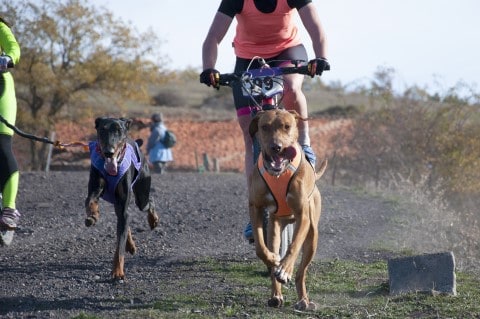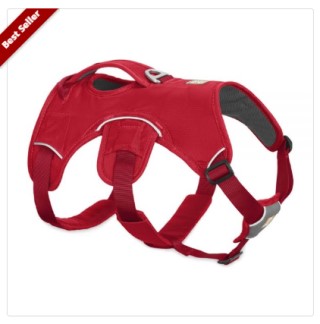
A fantastic alternative to collars & leads, the Ruffwear Webmaster Harness UK allows for numerous outdoor activities, including bikejoring. Here is a brief introduction to this exciting sport.
What is Bikejoring?
More exhilarating and potentially much faster than canicross, bikejoring is the evermore popular sport of cross-country biking with one or more dogs pulling the bike or dog scooter. A similar sport more suitable for Winter is skijoring, where dogs pull their humans on cross-country skis.
Why Go Bikejoring?
Apart from giving you an opportunity to have an exciting, fun time with your pooch every time you get onto a trail, bikejoring also helps dogs and their humans learn to think and work as a team.
More importantly, it is also a fantastic way to exercise your furry friend – particularly if he loves to run and tends to yank your arm out of its socket every time you take him for a walk.
Happier and healthier when allowed to exercise at their own pace (i.e. faster than their humans can run), well exercised, trained and experienced dogs are also calmer (especially important in new situations) and can be directed (i.e. how to move through/deal with crowds) easier during walks.
Bikejoring Equipment
So, what do you need to start your bikejoring adventure? First, you will obviously need a reasonably sturdy bike. While any bike will do at a push, it is best to use a bike that is suitable for cross country biking. Basic “hardtail” mountain bikes are great to start with. Good brakes are a must – you will have to rely on your brakes for safety reasons – and for this reason, many experienced bikejoring enthusiasts prefer disc brakes.
You will also need:
- Personal safety equipment (gloves, hat, glasses, etc.)
- A comfortably fitting dog harness (the Ruffwear Webmaster Harness is ideal – see more below) designed to take pressure of your pooch’s throat while pulling your bike
- A long bungee lead (the shock-absorbing quality of which is essential to protect both you and your best friend from the force expended when he pulls suddenly) to connect the harness to the bike. To provide your pooch with ample space and allow him to run clear of your bike’s front wheel, this lead must necessarily be longer than a lead you would use in canicross.
- A bikejoring attachment to prevent the lead dropping into the bike’s front wheel and causing tangles if your pooch slows down suddenly stops.
As a beginner, it is advisable to find a bikejoring group/club who may be able to let you borrow some equipment or, if this is not the case, at least offer you some helpful advice on the best products to purchase and the best places to go bikejoring (more about that later). Bikejoring UK is a good place to start looking for contacts.
Ruffwear Webmaster Harness UK
 Easy to attach to leads, human harnesses and bikes, the Ruffwear Webmaster Harness is a highly supportive multipurpose harness designed for assisting & manoeuvring dogs (i.e. over obstacles), designating working dogs and prevent even renowned canine “Houdinis” from making their escape.
Easy to attach to leads, human harnesses and bikes, the Ruffwear Webmaster Harness is a highly supportive multipurpose harness designed for assisting & manoeuvring dogs (i.e. over obstacles), designating working dogs and prevent even renowned canine “Houdinis” from making their escape.
Anatomically designed and featuring five adjustment points to ensure a secure, comfortable custom fit, this harness boasts foam-padded belly and chest straps to provide comfortable support without hindering the dog’s range of motion.
Combined with two lead connection points, a reflective trim to enhance log-light visibility and a handy signage attachment platform, this makes it the preferred harness of many service and avalanche rescue dog handlers – and ideal for hiking, scrambling and, of course, bikejoring.
Starting Bikejoring Training
Starting training is best done by training voice commands during walks. Make sure to decide early which commands you will use for ‘right’ & ‘left’ and do try to get a good command for ‘slow down’ from the beginning. While there are no rules as to what commands to use and you are free to use any commands you wish, traditional sled dog commands are a great way to get started. These commands are:
- Hike or Mush – to start/encourage your pooch to move
- Haw – to turn left
- Gee – to turn right
- Straight on – to keep going straight (i.e. if there are multiple options) on the trail
- On by – to pass another team of dogs/dog
- Easy – to slow down and
- Whoa – to stop
When starting training, you may use your lead to guide your dog into the right direction and/or slow/stop him while giving the relevant left, right, slow down or stop commands.
To begin with, your pooch may be a little reluctant to run ahead of the bike, so you may need to encourage him to do so.
Encouraging Your Dog to Run Up Front
Here are a few methods you can try to encourage your furry companion to run up front:
- Raise the pitch of your voice to prepare your pooch for activity and signal to him that you want him to up his energy. It may sound odd, but dogs do respond to voice pitch changes – and he will quickly learn that raising your pitch means fun.
- Join a bikejoring group to allow your dog to learn from experienced dogs. Dogs do learn from one another and often compete naturally with peers.
- Get someone to bike/run ahead of you. Dogs naturally love to chase and having someone ahead of you may motivate him into staying up front. It is, however, important to only use this method as an occasional tool to build your pooch’s confidence and encouraging him as much as possible to run independently instead. Let’s face it – training your furry friend to chase is not always a good thing!
You could also use a favourite toy, encouraging him to fetch it, but for the same reason as above, this should also only be used from time to time to help him gain confidence.
Finally…
Last, but by no means least importantly, bikejoring can be somewhat more complex compared to canicross, and many landowners do not permit training on their land – so do make sure to check where you can train. It is also highly recommended to take out some sports insurance (both for training & racing).
What’s more, training on some land owned by Forestry Commissions requires a permit to train – and such permits typically require public liability insurance up to £5 million. Again, Bikejoring UK may be a good place to learn more about this.
